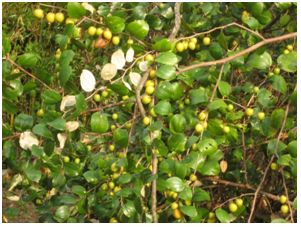
Botanical Name – Ziziphus mauritiana Lam.
Common Name - Indian Jujube, Ber
Classification:-
Kingdom - Plantae
Division - Magnoliophyta
Class - Magnoliopsida
Order - Rosales
Family - Rhamnaceae
Genus - Ziziphus
Species - mauritiana
Characteristics Of Euphorbiaceae Family-
Plant trees, shrubs or climbers, climbing by hooks or tendrils; leaves single, stipulate, stipules often spiny, cymose in florescences; flowers hermaphrodite, perigynous; sepals 4-5 free; petals 4-5, free; stamens opposite the concave petals; a well developed intrastaminal disc present; carpels 2-4, 2-4 locular with one basal ovule in each locule, fruit drupe or capsule seeds hard.
Habitat:- tropical and subtropical woodland, savannah, coastal plains, pasture land, roadsides, riparian habitats and former farmland.
Distribution:- widely distributed through the arid and semi-arid regions of the Mediterranean, Australia, West Indies, Eastern and Sahelian Africa, the Middle East and the USA
Status:- Least concern
Plant description:-
Ziziphus mauritiana is a spiny, evergreen shrub or small tree up to 15 m high, with trunk 40 cm or more in diameter; spreading crown; stipular spines and many drooping branches. The fruit is of variable shape and size.
USES-
Liver disease, Muscular conditions, Ulcer, Dry skin, Wounds, Diarrhea etc.
The fruit is eaten raw, pickled or used in beverages. It is quite nutritious and rich in vitamin C.
It contains 20 to 30% sugar, up to 2.5% protein and 12.8% carbohydrates.
Fruits are also eaten in other forms, such as dried, candied, pickled, as juice, or as ber butter.